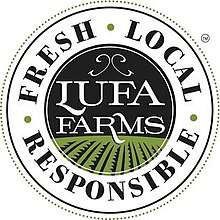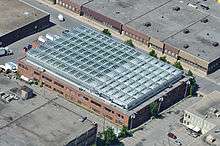Lufa Farms
Lufa Farms is an urban agricultural company located in the Ville Saint-Laurent neighbourhood of Montreal, Quebec. The company states its mission on its website is to grow food where people live and grow it more sustainably.[1][2] The company, founded in 2009, has installed commercial greenhouses on the rooftops of several large industrial buildings in the greater Montreal area, the first of which, located in the Ahuntsic borough of Montreal, was the world's first rooftop commercial greenhouse.[2][3]
 | |
| Private | |
| Industry | urban agriculture, hydroponics, roof garden |
| Founded | 2009 |
| Headquarters | , |
Key people | Mohamed Hage (Founder, CEO) Kurt Lynn (Founding Member, Vice President) Lauren Rathmell (Founding Member, Greenhouse Director) Yahya Badran (Founding Member, Director of Engineering) Dave Furneaux(Chairman) |
| Products | Subscription-based food ecommerce |
Number of employees | 200 |
| Website | lufa.com |

Description
Lufa Farms believes that the current food system is not sustainable and that cities need to transition to a new food production model that’s self-sufficient enough to continue to feed a growing metropolitan population. The company achieves this by growing more food, closer to where people live, while using less space and resources to minimize environmental impacts, and remaining completely transparent.[2][3]
With three rooftop greenhouses in the Montreal area, the company currently has 138,000 square feet of growing space where dozens of types of vegetables are grown. The company currently delivers around 20,000 baskets every week to over 500 pick-up points across Quebec,[2] and in 2020, upon completion of their fourth greenhouse, the 164,000-square-foot space will enable them to feed up to 2% of Montreal households.[2][4]
History
2009
CEO and founder Mohamed Hage was born in Lebanon and grew up surrounded by rooftop gardens. Upon moving to Canada, he was surprised to find that vegetables often travel over 2,000 km before being eaten. It was this knowledge combined with the simplicity and accessibility of rooftop farms that led him to bring together a team to tackle the mission to encourage cities to eat locally and responsibly. There was Lauren Rathmell to manage the greenhouses and plant science, Kurt Lynn for his decades of marketing experience, and Yahya Badran to manage the construction and engineering projects.[1][5]
2010
The company began construction of their first commercial rooftop greenhouse in the Ahuntsic borough of Montreal. In addition to the 31,000 square feet of vegetable production, the two-story building also served as the company's head office and distribution centre. Currently, it houses the company's herb, micro-greens, cucumber, and pepper production using both horizontal and vertical farming systems.[1][3]
2011
The company harvested their first rooftop vegetables and began delivering weekly baskets to their first cohort of clients, aptly named "Lufavores" (a contraction between 'Lufa' and 'locavore'). At that time, the company grew only 40 varieties of vegetables and delivered to about 200 customers without the option to customize the order. The baskets were delivered steps from customers doors thanks to a network of neighbourhood pick-up points (PUPs).[1]
2013
Lufa Farms built their second rooftop greenhouse in the neighbouring city of Laval, measuring 43,000 square feet and currently housing the company's tomato and eggplant production.[3] In order to offer more variety, they partnered with hundreds of local farmers and foodmakers to offer Lufa Farms' rooftop-grown vegetables, as well as thousands of seasonal field fruit and vegetables, baked-to-order bread, seafood, and more. These partnerships brought the launch of the company's online farmers’ market, the Marketplace.[1]
2016
The company went through a period of major growth. The total number of weekly baskets exceeded 10,000 and the company had to double its workforce to keep up. It was also the year that Lufa Farms' eco home delivery by electric car was launched and the company became cash-flow positive.[1]
2017
Lufa Farms built their third rooftop greenhouse in the Anjou suburb of Montreal. This greenhouse, which was both their largest and most technologically advanced, grew the company's growing space to 138,000 square feet and allowed the company to expand production capacity to include more than one hundred varieties of vegetables, and feed over 10,000 Montreal households year-round.[1]
2019
The company outgrew their Ahuntsic location, and moved their main offices and distribution centre to Ville Saint-Laurent where they began construction on their fourth, and largest rooftop greenhouse.[1][6]
2020
The company is forecasting the completion of their Ville Saint Laurent greenhouse for the spring of 2020. Once finished, it will become the world's largest rooftop greenhouse at 164,000 square feet (about three football fields) and will house the company's complete tomato and eggplant production. The surface area will be greater than all three of their current greenhouses combined and will double the company's growing capacity, allowing them to feed up to 2% of Montreal households with local vegetables.[1][4]
Advantages of rooftop farming
No new land
Lufa Farms opts for growing food on rooftops as it uses no new land, gives purpose to unused spaces, and enables food to be grown locally instead of being transported from miles away. Rooftop farms help to mitigate the problem of wasted heat islands, filter CO2, and put oxygen back into the air.[3]
Saving water
Lufa Farms grows their food in a coconut fibre substrate using a hydroponic system. Water is recirculated and rain and meltwater are added into the closed-loop system, effectively using 50% less water than a farm of comparable size not recirculating water.[3]
Saving energy
Rooftop greenhouses trap and use the residual heat let off from the building below and act as a protective buffer against the elements, thereby reducing the building's heating needs. Through the use of energy curtains and natural gas heaters, Lufa Farms' greenhouses use about half the energy used to heat an equivalent, ground-level greenhouse. In the summer, natural plant transpiration cools the greenhouse and consequently helps to mitigate the heat island effect produced by black tar rooftops.[3]
Controlling Pests
Lufa Farms uses no synthetic herbicides, fungicides, or pesticides. Instead, they rely primarily on bio-controls consisting of the introduction of predatory insects.[3]
Reducing waste
Green waste is composted and sold on Lufa Farms' Marketplace or is sent to municipal or other partner composting sites.[3]
Gallery
 Mohamed Hage, founder of Lufa Farms.
Mohamed Hage, founder of Lufa Farms. Plant science team member.
Plant science team member. Vegetables harvest.
Vegetables harvest. Preparation of vegetable baskets.
Preparation of vegetable baskets. Boston lettuce.
Boston lettuce. Tomato rows.
Tomato rows. Chard Growing in nutrient film system.
Chard Growing in nutrient film system.
 Construction of the new greenhouse in Laval, Quebec (2013).
Construction of the new greenhouse in Laval, Quebec (2013).
See also
References
- "Lufa Farms". https://montreal.lufa.com. Retrieved 2020-03-09. External link in
|website=(help) - Brownstein, Bill; November 21, Montreal Gazette Updated:; 2019 (2019-11-21). "Brownstein: Montreal's Lufa Farms reaches new heights | Montreal Gazette". Retrieved 2020-03-09.CS1 maint: extra punctuation (link) CS1 maint: numeric names: authors list (link)
- "Discover our farms". https://montreal.lufa.com. Retrieved 2020-03-09. External link in
|website=(help) - Farms, Lufa. "Lufa Farms breaks ground on their fourth greenhouse, making Montreal home to the world's largest rooftop farm". newswire.ca. Retrieved 2020-03-09.
- Radio-Canada.ca, Zone radio-; Radio-Canada.ca, Zone radio-. "La générosité de la serre Lufa | C'est bien meilleur le matin". La générosité de la serre Lufa | C'est bien meilleur le matin | ICI Radio-Canada Premi�re (in French). Retrieved 2020-03-09.
- "It's moving time!". https://montreal.lufa.com. Retrieved 2020-03-09. External link in
|website=(help)